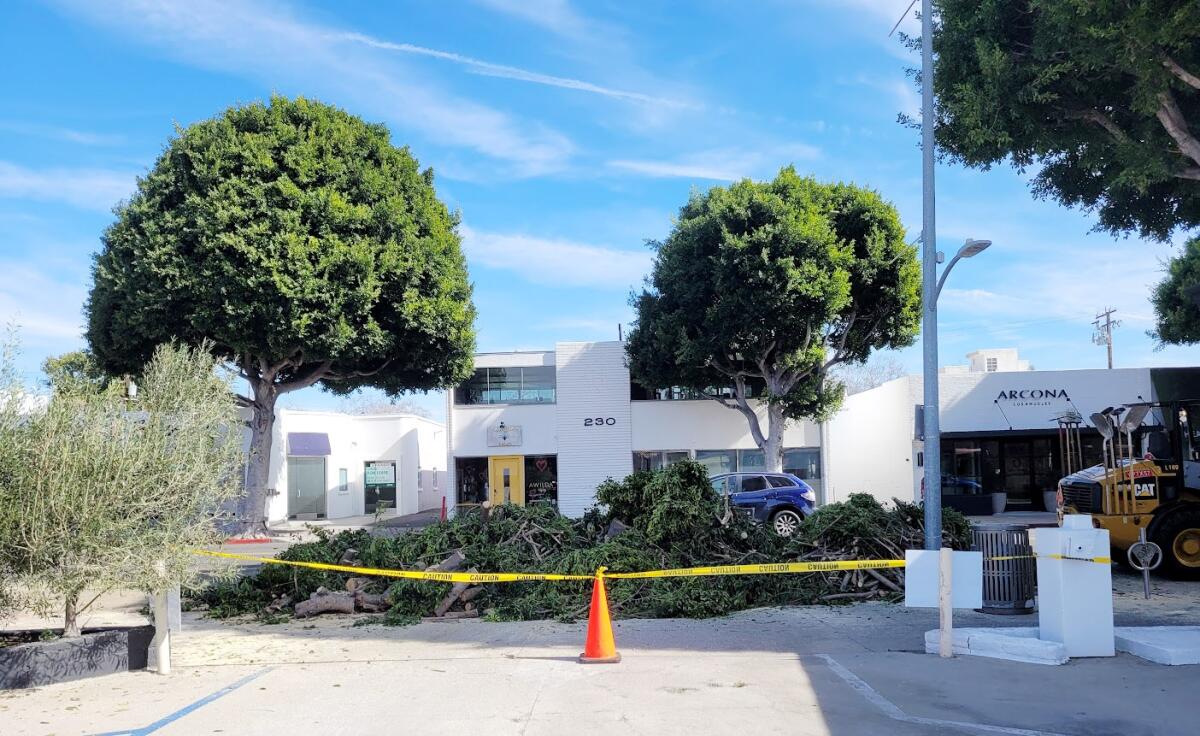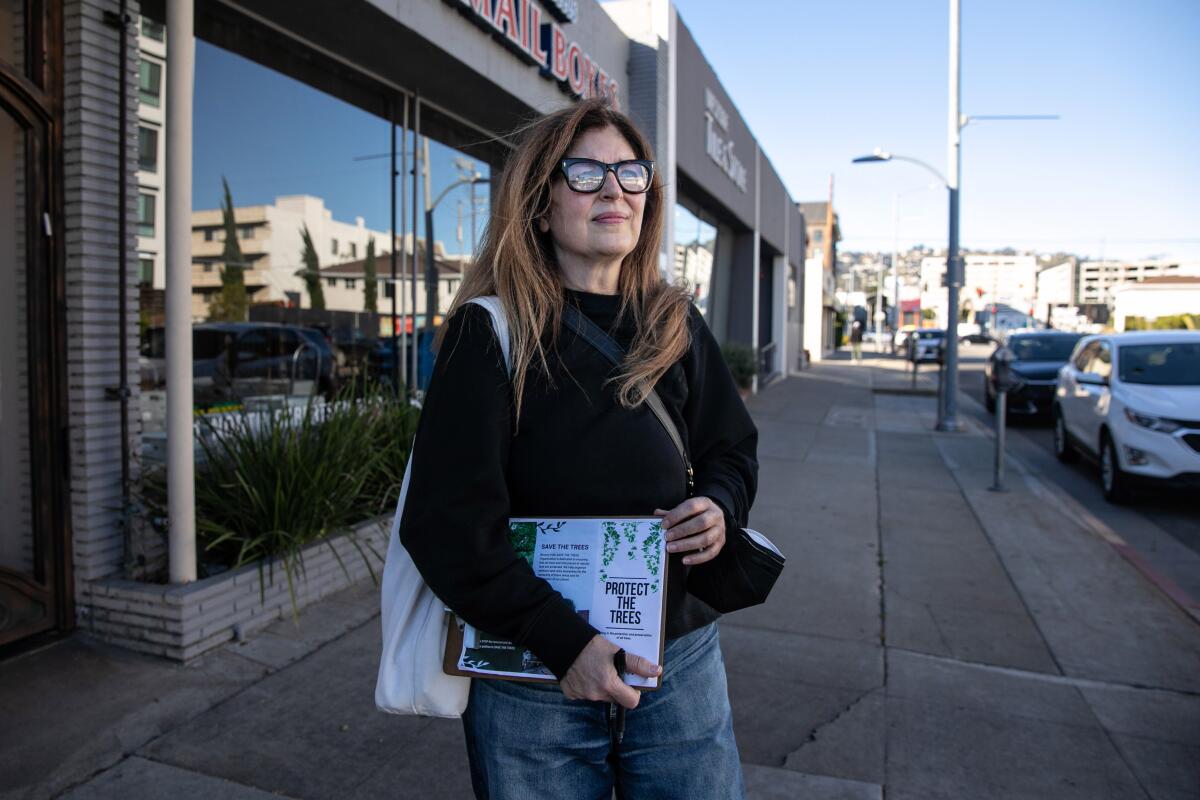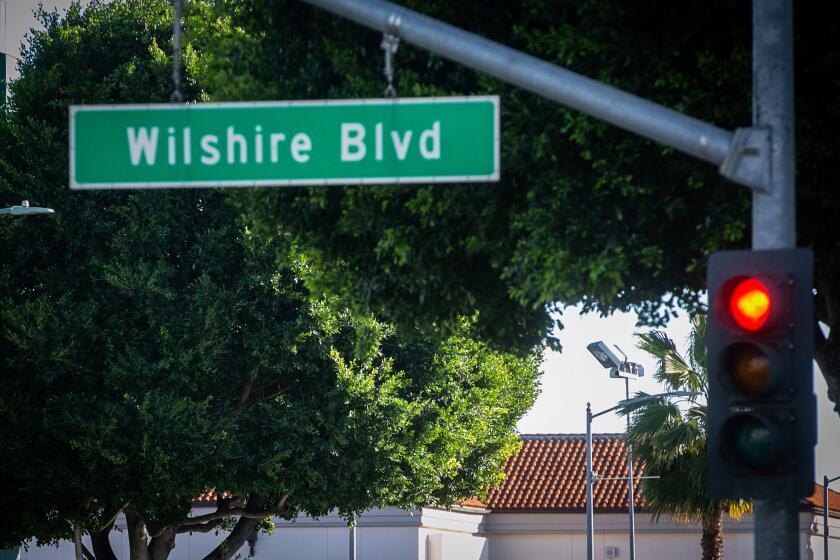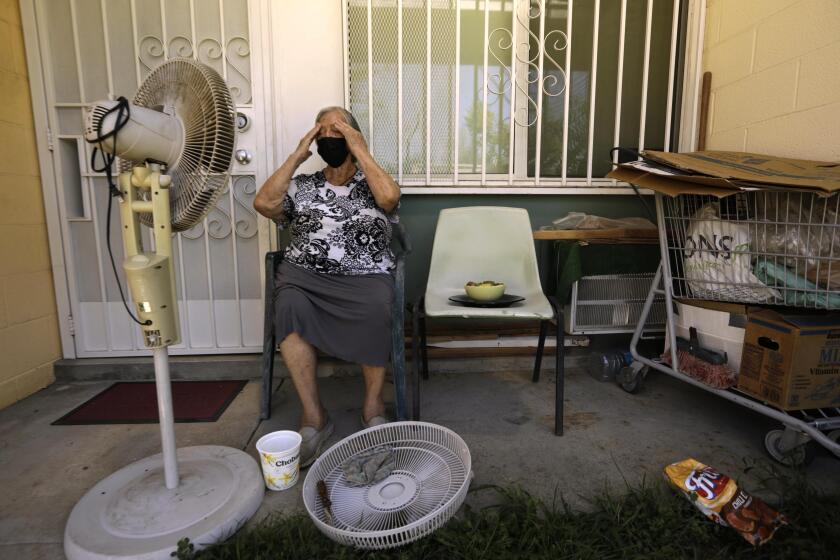As Beverly Hills bakes, court grants shady trees a temporary reprieve from chain saw

- Share via
Tree advocates in Beverly Hills have won a reprieve for dozens of Indian laurel figs that were slated to be razed by the city after arguing in court, in part, that the mature trees provided critical shade for humans and wildlife in a warming world.
Recently, Los Angeles County Superior Court Judge James C. Chalfant granted the Robertson Boulevard Special Task Force a preliminary injunction to halt the city from clear-cutting 36 Indian laurel figs, commonly known as ficus trees, on Robertson Boulevard, one of the city’s major commercial corridors. Crews have already felled more than 50 trees as part of a sidewalk renovation project, but opponents argued in court filings that the city failed to properly consider the environmental impacts of the trees’ removal.
“I’m just ecstatic, and my clients are ecstatic,” said Jamie T. Hall, a land use and environmental attorney with Channel Law Group LLP who is representing the task force.
Some 87 ficus trees on Robertson Boulevard will be cut down for a sidewalk project. For some, the removals are bittersweet. For others, they feel like a death.
The judge’s order comes as humanity experiences its hottest July on record and at a time when cities are being urged to expand their tree cover to protect residents and wildlife from the worsening effects of climate change.
But, despite recommendations to expand tree cover, some municipalities are choosing instead to reduce it, Hall said.
“This is happening across the state, and cities are trying to find a shortcut — they want to downsize the urban canopy and they don’t want to do the required environmental analysis,” Hall said. “I hope this is a warning sign to other cities that they cannot shortcut the environmental analysis required by law, and that they must consider the environmental consequences of their actions both for existing urban residents and for the wildlife that call cities home.”
In an email, the city of Beverly Hills said it would continue with its sidewalk improvement project and will follow the judge’s preliminary injunction until a final order is issued. “In the meantime, the City will continue to explore all additional options,” the email said.
A different judge issued a temporary restraining order in late March forbidding the city from chopping down more trees until the preliminary injunction. The case was reassigned to Chalfant in June.
Crews began cutting the trees in Beverly Hills in February as part of a more than $7-million sidewalk restoration project, which involved plans to cut down some 87 60-to-100-year-old ficus trees and replacing them with alternating crape myrtles and Mexican fan palms. The project will include the removal and replacement of sidewalks, curb ramps and more, and the installation of an irrigation system.
The city and some business owners blamed the ficus trees for leaving messy droppings, causing drainage issues, and damaging buildings and sidewalks. Beverly Hills’ public information officer said the city had received several trip=and=fall claims in recent years, and that it could no longer repair the sidewalk without replacing it, which would have required “eight inches of excavation and would destabilize the trees.”
Incensed by the city’s actions, local resident and business owner Wendy Klenk launched a campaign to convince officials to prevent more tree cuttings and find other solutions, forming the Robertson Boulevard Special Task force in the process.
Klenk and other tenants and business owners filed a lawsuit against the city alleging the removals would cause irreversible harm to the street’s businesses and wildlife, and that they were not adequately notified the trees would be cut down.

In a court filing, the city’s attorneys said the city “engaged in extensive public outreach” for years and held numerous public meetings to discuss the sidewalk repairs and the removal and replacement of the ficus trees before the project was approved in December. They also claimed the crape myrtles would provide similar amounts of shade and noise reduction.
The city’s public information officer said project notices were hand delivered to businesses along Robertson in July 2022 and mailed to those within a 500-foot radius of the project.
A task force also alleged that the city violated the California Environmental Quality Act (CEQA) by “improperly determining” the project was exempt from reviews required by the law, and that it did not provide records as required by the California Public Records Act.
The city’s attorneys claimed the project was exempt from CEQA because it involves the repair and maintenance of existing facilities, which includes sidewalks and street trees.
A hearing date on the matter has not been set.
Since the city began removing the trees, business owners on Robertson Boulevard have incurred “significant and unnecessary expenses, real damages such as increased electrical bills, product damages from sun and heat exposure, increased indoor temperatures, [and] environmental and noise pollution” from the loss of the shade canopy that the trees provided, according to a release from the task force about the preliminary injunction.
Some have also had to purchase window treatments and awnings to “mitigate the effects of the sun and extreme heat.”
For Klenk, the judge’s order is a welcome, albeit temporary, relief.
“We’re incredibly worried about the trees,” she said. “Especially now with the heat, cities everywhere are saying they need to preserve our mature trees not only for the shade canopy, but the cooling effect on the ground… so we were thrilled. We had no idea one way or another how the judge was going to rule.”
Paved surfaces, tree cover, and home construction quality can make the difference between heat waves being an inconvenience or a threat to your life.
While the judge’s order was great news for some Beverly Hills’ residents and business owners, many other areas in Los Angeles County lack tree cover.
Numerous studies have shown that the tree canopy — and consequently heat — is distributed unevenly across the county, with low-income communities and communities of color tending to have less green coverage, and disproportionately suffering the consequences of worsening heat waves and air pollution.
One recent study led by UCLA found that residents who live in affluent areas with more tree coverage like Beverly Hills had median life expectancies as high as 90 years compared to South L.A. communities, where the median life expectancy is 77 years.
Esther Margulies, professor with the USC School of Architecture and Dornsife Spatial Sciences Institute, has been working with a team to address tree canopy inequity in L.A. Eastside communities like Lincoln Heights, El Sereno and Ramona Gardens.
City Terrace, she said, is a particularly interesting place. “There are areas [there] where there are few street trees, and those are residential neighborhoods and commercial streets where they are experiencing extreme heat, and they are going to have even more extreme heat, and they definitely need more trees.”
More to Read
Sign up for Essential California
The most important California stories and recommendations in your inbox every morning.
You may occasionally receive promotional content from the Los Angeles Times.













